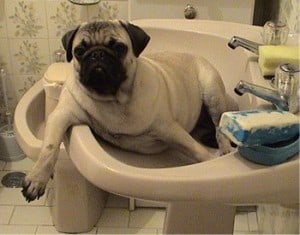A good place to start is to give him a good quality food.
Read the recommendations on the label;
This will give you an accurate weight of the dog and a estimated target weight.
Now, from the table, figure out his activity level.
Also factor in the other environmental variables and any additional calories that he may put on, in the form of treats or table foods, and then adjust the starting amount.
Perhaps your vet should be able to tell you what your dog’s ideal weight should be.
Factor this too in your feeding amount.
Take into consideration that most dogs are overfed and do hardly any exercise. If this is the case with your pet too, then it’s wise to feed him just a little less.
Once you begin feeding him the amount as per your calculations, weigh your Pug once a month to determine if the feed is appropriate. If necessary, increase or decrease the amount of food slightly until your pet achieves his ideal weight.
If he gets too frisky on the weighing scale, one good way of doing it is to get onto the weighing scale with him and then release him and weigh yourself without the dog. Subtract the difference to get his weight.
As time passes and your Pug grows older, you will find that the amount you feed him changes. He will put on weight and might be overweight as he grows into an adult. This is the time his appetite is far larger than his need for food.
His weight also increases when he begins to age and his physical activity level begins to wane. At this time too, you could adjust his calories and conduct periodic weight checks, and reduce the quantity of each feed.
How often to feed your pup
Feed your hungry Pug puppy not more than three times a day. If you find he isn’t hungry that often, reduce the number of meals. At age 10-12 weeks, begin feeding him just twice a day.
Ideally, you should give him just two meals, morning and evening, leaving his bowl of food before him for 15 minutes each time, so that he eats as much as he can within that time. Then, pick up his bowl of unfinished food.
The reason for doing this is that he won’t be encouraged to overeat, which he would if he has the bowl of food before him for as long as he wishes. If, as a pup, he is overweight, he is more likely to suffer from hip dysplasia and other weight problems as he grows.
Also, if you continue to feed him through the day, he will never be hungry for his meal, and so won’t enjoy it unless it comes with special treats. This combination of special treats and freely available food leads him to be bored, picky and overweight.
People food
Don’t give your Pug dog the food you eat. Food meant for humans and scraps from your dining table should never be given to dogs.
If you begin with giving him a balanced diet and to that add goodies from your table, there won’t be much of a balanced diet for him anymore, but certainly you will give him a lot of digestive trouble.
You could, however, do the reasonable thing by balancing treats such as milk bone biscuits with his canned food, but again, don’t overdo it.
Apart from the above, you may confidently feed your Pug any proprietary dog biscuits, fresh, cooked or canned meat, an egg, vegetables, rice or pasta but in reasonable quantities.
Some pet owners feed their dogs just dog foods that, though are less natural, and are completely balanced diets. You will find that they come in many forms and shapes—for instance, they may be biscuits, kibble or flakes.
If you feel that your Pug’s diet must also take into consideration problems such as scratching, overweight or poor coats, ask your vet to advise you on the local products available.
Perhaps your Pug does not need a high protein diet that might otherwise have made him prone to scratching and perhaps a mild form of eczema too.
No matter what diet you eventually follow, bear in mind that the protein content of your Pugs diet should be kept very low. His grain content should come solely from barley, wheat and rice.
Desist from feeding him lamb, poultry, ocean fish, avocado or yellow corn. In fact, they will eat pretty much anything just so long as it is delicious. A friend’s Pug eats homemade cooked bacon, steaks, lamb chops and stew.
Food for his coat
When you look for good food for your Pug’s coat, fatty acids and oils are important. To test, take about a cup of dog food and put it into a small brown paper bag. Leave it for about an hour and then check it. If the food has been cooked in a lot of oil, the paper bag will have oil stains on it.
There are a number of good foods that will behave in a similar manner. So, when you choose dog food, look into a whole lot of other things too such as food allergies your dog may suffer from, what makes up dog food and its quality and availability.

